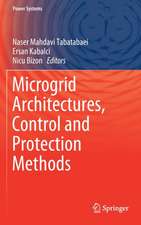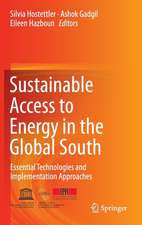The Power Supply Industry: Best Practice Manual for Power Generation and Transport, Economics and Trade
Autor Panos Konstantin, Margarete Konstantinen Limba Engleză Hardback – 22 ian 2018
The book comprises eleven chapters, 35 tables, 100 figures, 35 application examples and 10 case studies
Target audience of the book areprimarily international consultants, staff members of engineering companies, utility personnel, energy economists and lawyers, as well as employees of government agencies entrusted with regulating the energy and utility sector and, finally, students in related fields of engineering and economics.
| Toate formatele și edițiile | Preț | Express |
|---|---|---|
| Paperback (1) | 567.50 lei 38-44 zile | |
| Springer International Publishing – 9 iun 2019 | 567.50 lei 38-44 zile | |
| Hardback (1) | 583.95 lei 38-44 zile | |
| Springer International Publishing – 22 ian 2018 | 583.95 lei 38-44 zile |
Preț: 583.95 lei
Preț vechi: 729.93 lei
-20% Nou
Puncte Express: 876
Preț estimativ în valută:
111.75€ • 116.24$ • 92.26£
111.75€ • 116.24$ • 92.26£
Carte tipărită la comandă
Livrare economică 11-17 aprilie
Preluare comenzi: 021 569.72.76
Specificații
ISBN-13: 9783319723044
ISBN-10: 3319723049
Pagini: 374
Ilustrații: XXV, 374 p. 158 illus., 95 illus. in color.
Dimensiuni: 155 x 235 mm
Greutate: 0.79 kg
Ediția:1st ed. 2018
Editura: Springer International Publishing
Colecția Springer
Locul publicării:Cham, Switzerland
ISBN-10: 3319723049
Pagini: 374
Ilustrații: XXV, 374 p. 158 illus., 95 illus. in color.
Dimensiuni: 155 x 235 mm
Greutate: 0.79 kg
Ediția:1st ed. 2018
Editura: Springer International Publishing
Colecția Springer
Locul publicării:Cham, Switzerland
Cuprins
Basics of Technical Thermodynamics.- Basics Techno-economics of Power System.- Thermal Power Plants Fired by Fossil Fuels.- Nuclear Power Plants.- Power Generation from Renewable Energies.- Cogeneration of Power and Heat.- Cost Allocation to Cogeneration Products.- Transmission and Distribution of Power.- Electricity Trading.- Development and Implementation of Projects.- Case Studies.
Notă biografică
The book reflects the knowledge drawn from over 35 years of experience of Panos Konstantion as a consultant for engineering and economics of power and energy system projects worldwide.
Textul de pe ultima copertă
Power and Energy industry is a highly capital intensive business field. Furthermore there is a very close interlinkage between technologies and economics that requires engineering consultants, economists and lawyers dealing with investments in this field to have a basic knowledge of the power sector technologies and a common understanding of project evaluation approaches and methodologies. The book’s overall objective is to provide a comprehensive but concise coverage of power supply technologies and the related economics as required for techno-economic evaluation of investments in power and business projects. Throughout the book, the emphasis is on transferring practical know-how rather than pure theoretical knowledge. This is also demonstrated in numerous examples derived from experience of respective projects. The book comprises eleven chapters, 35 tables, 100 figures, 35 application examples and 10 case studies
Target audience of the book are primarily international consultants, staff members of engineering companies, utility personnel, energy economists and lawyers, as well as employees of government agencies entrusted with regulating the energy and utility sector and, finally, students in related fields of engineering and economics.
Caracteristici
Applies a practical how-to approach, with numerous examples Written by an experienced practitioner Connects technology and economics for investment evaluations

























